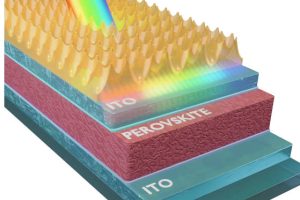
The perovskite of interest is CsPbBr3, which had to be formed into ‘nano-sheets’ within a particular structure, invented by the Pusan team, to achieve sufficient gain for lasing.
Update: Imec announced electrical pumping of a perovskite LED
Not that lasing was achieved, as the research project was intended to characterise such nano-sheets in terms of gain, temperature and other parameters to provide data from which future lasers can be designed.
The team “achieved enhanced signal amplification in nanosheets with a unique waveguide pattern, which enhanced both gain and thermal stability”, according to the university. “These advancements carry wide-ranging implications for laser, sensor and solar cell applications, and can potentially influence areas like environmental monitoring, industrial processes, and healthcare.”
Given the right conditions, CsPbBr3 spontaneously forms atom-thick squares around 150nm across from solution. Atomically fine dust – quantum dots – are another form that can be made to form spontaneously but, so far, these have have not provided sufficient gain for lasing.
Using micro-imprint lithography, the waveguide – a series of long parallel channels 20μm wide and 20μm deep, separated 20μm thick walls – was formed in a 20 x 20mm polyurethane-acrylate substrate.
These channels were filled with the CsPbBr3 precursor solution (see diagram) and carefully wiped with a blade multiple times to equally dose each channel.
Subsequent drying left a multi-crystal nano-sheet in the bottom of each channel ready for optical analysis – which is the speciality of the Pusan lab involved: the Department of Opto and Cogno Mechatronics Engineering.
“The Perovskite nanosheets possess characteristics that make them valuable for various applications,” according to the university. “Their achievement overcomes the shortcomings of CsPbBr3 quantum dots, whose gain is inherently limited due to the short decay time for population inversion.”

As part of the results, the researchers have created a novel metric: ‘gain contour’ (diagram left).
“We proposed a new gain analysis of gain contour to overcome the limit of earlier gain analysis,” Professor Kwangseuk Kyhm told Electronics Weekly. “While the old method provides a gain spectrum, it is unable to analyse the gain saturation for long optical stripe lengths. Because the gain contour illustrates the variation of the gain with respect to spectrum energy and optical stripe length, it is very convenient to analyze the local gain variation along spectrum energy and optical stripe length.”
The excitation and temperature dependence of the gain contour were measured, which quantified the increase in nano-sheet gain and thermal stability due to the polyurethane-acrylate waveguide.
“This enhancement was attributed to improved optical confinement and heat dissipation, which was facilitated by the two-dimensional center-of-mass confined excitons and localised states arising from the inhomogeneous sheet thickness and the defect states,” said Pusan.
How does the device work?
Professor Kwangseuk Kyhm said:
For optical pumping, a circular laser beam becomes shaped into a narrow stripe by a cylindrical lens.
The rectangular optical stripe is similar to the nanosheet stripe, filled in a patterned waveguide, and the incident excitation light is normal to the patterned waveguide (channel).
As nanosheet stripes are excited, propagating light along the waveguide becomes amplified. Due to a patterned waveguide, amplification becomes enhanced.
Mainly we analysed the gain from a single channel, but multi-channel amplification is also possible if the excitation stripe width is large.
Pusan National University, of South Korea, worked with the University of Oxford, and results are published in the Journal: Light: Science & Applications as ‘Gain enhancement of perovskite nanosheets by a patterned waveguide: excitation and temperature dependence of gain saturation‘.
 Electronics Weekly Electronics Design & Components Tech News
Electronics Weekly Electronics Design & Components Tech News



